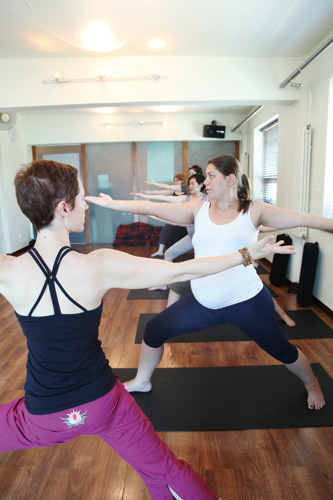
The 2013-2014 beijingkids Health Guide is the latest resource for Beijing families dedicated to providing information on family health care, maternity, eating and breathing safety, mental health, emergency care and traditional Chinese Medicine. Articles from the guide will be featured twice a week on our website. Find the full version here.
Most people take up yoga to boost flexibility or tone their torsos, but for mothers-to-be there’s a practical, albeit less common, reason to stretch out on a matt – it can help women have healthier pregnancies.
A yoga teacher since 1998, owner Robyn Wexler opened Yoga Yard with fellow yoga expert Mimi Kuo-Deemer in a renovated courtyard near Dongsi in 2002. Business was brisk from the start and the Yoga Yard soon moved to a larger location and eventually settled in it current location in the Bodhi Spa complex across from the north gate of the Workers’ Stadium. Today it is one of the most popular yoga studios in the international community.
Wexler, a mother of two boys, explains the back pain, stiffness, headaches, swollen extremities, and other ailments that pregnant women commonly endure can all be eased by prenatal yoga. But those sessions are carried out in a different fashion than one might expect.
“A lot of people, when they think of prenatal yoga, imagine a lot of stretching,” she says. “There’s definitely some of that in our classes to maintain flexibility. But we also do a lot of poses to maintain body balance and strength, because a lot of joint pains during pregnancy come from having no stability.”
She also says those off kilter issues occur as bellies grow during pregnancies, shifting women’s center of gravity.
“Position and posture of the body can do a lot to prevent pain that is otherwise very common,” Wexler says. “On a physical level it helps to alleviate problems and discomforts. But it also gives people a better awareness of their bodies.”
But some women have trouble wrapping their minds around the notion of trying such poses, or any physical activity in general as they fret about the risks to the babies they’re carrying.
Zhang Yuchun, founder of the pregnant mother’s club at FORKISS yoga studio, says prenatal sessions aren’t dangerous. In fact, he feels that such classes prevent risks.
“Prenatal yoga encourages the pregnant mothers to maintain good posture,” he says. “That, in turn, promotes blood circulation, and improves oxygen supply to the placenta’s blood supply, aiding in the baby’s nutrition.”
Dr. Stefan Schneyer, Chief of Obstetrics and Gynecology at Oasis International Hospital, also touts prenatal yoga’s attributes. “Prenatal yoga is a perfect marriage between relaxation of the body and mind,” says Dr. Schneyer. “It helps with physical preparation for one of the most wonderful, but stressful, moments in the life of a woman, which is giving birth.”
While those benefits may seem more than enticing, Zhang concedes that many mothers still may be wary of the risks that yoga may pose to their unborn babies. He says those concerns can be especially common among Chinese women, a notion that may stem from generations’ old traditions that demand women live gingerly for the duration of their pregnancies.
“For many people, Chinese traditional concepts still often play a really important role in pregnancy,” he says. “First of all, people traditionally believed that it was much safer to rest than do activities. Secondly, yoga’s prominence in China came relatively late and pregnant yoga has only been accepted in recent years.”
While those concerns may be warranted, Wexler says professional prenatal yoga instructors go to great lengths to ensure their students are safe and comfortable.
“It can be as simple as, while standing up in mountain pose, changing the classical narrow stance into a wider stance so that you have more support,” she says of the subtle shifts that make prenatal yoga more comfortable, before describing the aspects that make it safer: “Some postures are not appropriate during pregnancy. There are no big back bends, and none of the contracting twists which that are a very common part of other types of yoga. And obviously we don’t include any poses that involve lying on your belly.”
Aside from those general rules of thumb, Wexler says prenatal yoga teachers also tailor their instructions to each student. This crucial component is what leads each class off— instructors have the students gather, say their names and how many weeks they are on in the course of their pregnancy, along with mentioning any areas of discomfort like lower back pain, recent dizziness, or disruptions in their sleep patterns.
“It’s important that the teacher understands the fragility of pregnancy, along with what’s happening at different stages,” Wexler says of the details that students disclosure before each class starts. She also emphasizes how crucial it is for instructors to know about any alarming ailments or irritations. “Some students might have common discomforts – their pubic bone might really be hurting, or their groins are really sensitive when they walk or get out of a car. We’d recommend students with problems like that not take part in poses that others can do. It’s important that the teacher knows which poses are appropriate for which students and how to adjust.”
But regardless of irritations or stages of pregnancy, Wexler says all prenatal yoga students need to gently ease into the poses and rhythms of the class. A key example is that, during pregnancy, a hormone called relaxin increases in the body, and tissues are softened as a result. Wexler says those more tender tissues are very helpful during childbirth, because the pelvis then literally has more wiggle room. But it also leads to several common pregnancy tribulations like lower back pain, because of the degree to which the tissues are loosened. And that lax flesh and muscle also prohibits students from attempting pretzel-like, hyper complex poses, at least with any degree of safety.
“During pregnancy, it’s really important to not go to the absolute extreme. It’s not the idea of exploring your boundaries and pushing your limits, because it’s much easier to strain a ligament or pull a muscle,” she says of the limits that relaxin softened tissue imposes on prenatal yoga students.
That eased approach not only makes prenatal yoga safer for the body, it also offers plenty of non-physical benefits that become extremely handy during such an emotional, hormonally ricocheting period.
“Prenatal yoga is a slow, mindful practice. It puts a lot of focus on breaths, being aware of your breaths and learning slow breathing to calm your nervous system … People find it useful and soothing during pregnancy and child birth, or afterward when you have a crying child and you’re trying to remain calm yourself,” she says with a laugh.
Gaining an understanding of breathing pales in comparison to what Wexler sees as prenatal yoga’s biggest emotional benefit – its ability to help pregnant women become better acquainted with themselves.
“Having the opportunity to explore your body and make friends with it during pregnancy is fantastic, in my mind,” she says. “Some people enjoy the process of pregnancy, but other people feel really sick the whole time. But being there in a class, and having time dedicated to these poses, can make you feel like ‘this is for me – I’m doing this for myself and my baby.’ On an emotional level, I think that’s really nice.”
Yoga Yard
6/F, 17 Gongti Beilu (across from the north gate of Workers’ Stadium), Chaoyang District. (6413 0774) 朝阳区工体北路17号6层工人体育场北门对面 info@yogayard.com, www.yogayard.com
FORKISS Pregnancy Club
F102 Phoenix City Arcade Street, Chaoyang District. (5866 7799) 朝阳区三元桥凤凰城商业街底商F102. BeijingBreastfeeding@gmail.com, www.forkiss.com.cn
OASIS International Hospital 9 Jiuxianqiao Beilu, Chaoyang District, Chaoyang District (400 UR OASIS (876 2747) 朝阳区朝阳区酒仙桥北路9号 http://www.oasishealth.cn
This article originally appeared on pages 34-35 of the beijingkids Health Guide.
Click here to see the Health Guide in full.
Can’t find the print edition? Send an email to distribution@beijing-kids.com
or call 5820 7700/7101. You can also browse the contents and comment on the beijingkids website.
Photo by Lova Li



